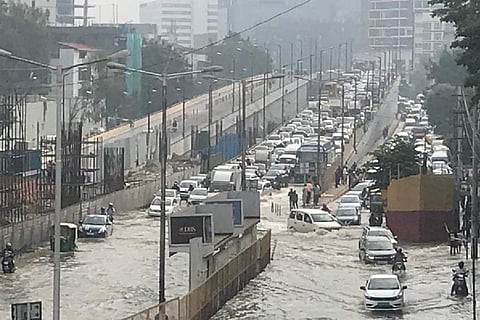

Outer Ring Road Companies Association (ORRCA) and The National Association of Software and Service Companies (NASSCOM) presented a proposal on improving the infrastructure on Bengaluru’s Outer Ring Road (ORR) and arterial roads on September 7. The proposal was submitted to the state’s Minister for Information Technology (IT) and Biotechnology (BT), C N Ashwath Narayan.
Bengaluru’s ORR and arterial roads act as a lifeline for all employees of IT and BT firms that lie on these roads. The associations, in their proposal, have suggested long and short term solutions for improving the same. The government, during a discussion with corporate and industry leaders of Bengaluru, have asked for a few days to review the proposal and a response is awaited. Ashwath Narayan said in his tweet, “Brand Bengaluru is resilient and has the tenacity to overcome temporary setbacks and issues. We have received a few suggestions from the @Namma_ORRCA representatives & industry experts, and it is being evaluated.”
We had a healthy and fruitful discussion today with corporate & industry leaders of #NammaBengaluru, in presence of the Chief Secretary of GoK, Sri @kris_sg, Chairman, Vision Group for IT-GoK, Commissioner of BBMP, DULT, BWSSB, BMRCL, @CPBlr, @blrcitytraffic & @ITBTGoK officials. pic.twitter.com/gn1f6GrB3i
— Dr. Ashwathnarayan C. N. (@drashwathcn) September 7, 2022
To address their immediate concerns, within 30 days to two months, ORRCA has suggested that an immediate resolution or restoration be done of the RMZ Ecospace and the impacted rajakaluves (stormwater drains). RMZ Ecospace is an IT hub at Bellandur in Bengaluru and had been inundated following the floods in Bengaluru. Further, they request for timelines of ORR metro project to be shared with the associations and ORRCA be made a part of the coordination group. They have also requested immediate completion of 19 arterial roads within six months, along with traffic management during ORR metro construction and consistent maintenance of ORR main carriage way and service roads.
ORRCA had met Hon. Minister for IT& BT Sri @drashwathcn with a comprehensive proposal to improve the infrastructure on ORR & Arterial Roads. Govt had asked few days to review & revert.
— ORRCA (@Namma_ORRCA) September 12, 2022
Dear @drashwathcn sir - looking forward to hearing from you soon! https://t.co/aSbUTlE2lS pic.twitter.com/ca8KIMX1Mz
Moreover, they have called for the 17 km stretch of the ORR to be declared as a separate municipal zone with a clear five-year plan to transform the corridor into a ‘world technology corridor.’ They have also asked for the governance framework of the new municipal zone to consist of public private partnership to ensure accountability and oversight by the IT and BT ministry.
Lastly, the ORRCA has also given suggestions such as the approval and execution of the cancelled high density corridor. A comprehensive execution plan for management of lakes and rajakaluves, zero tolerance policy for any encroachments that disturbs the ecological balance or disrupts traffic amongst others, has also been suggested.
This move by ORRCA and NASSCOM comes after Bengaluru’s IT corridor had experienced flooding after the torrential rains that lashed Bengaluru since September. After the floods, several environmentalists had pointed out that the flooding was due to the topography of the area, rapid urbanisation and poor infrastructure. It was revealed that many of the massive constructions in the Bellandur, Sarjapur and Marathahalli areas were encroaching many rajakaluves and canals, disrupting the flow of water from the many lakes presented in this area.
The Bruhat Bengaluru Mahanagara Palike (BBMP) had released a report saying that 126 lakes had overflowed in September after the downpour. With their flow being disrupted, and stormwater drains lacking the capacity, the lakes had burst open causing floods in the nearby areas. The data showed that Mahadevapura zone was the worst affected with 42 lakes overflowing. The outrage of residents that followed after the floods had pushed the BBMP into swift action with them taking up demolitions of many encroachments. A majority of the encroachments have been identified in Mahadevapura, Bommanahalli and Yelahanka zones.